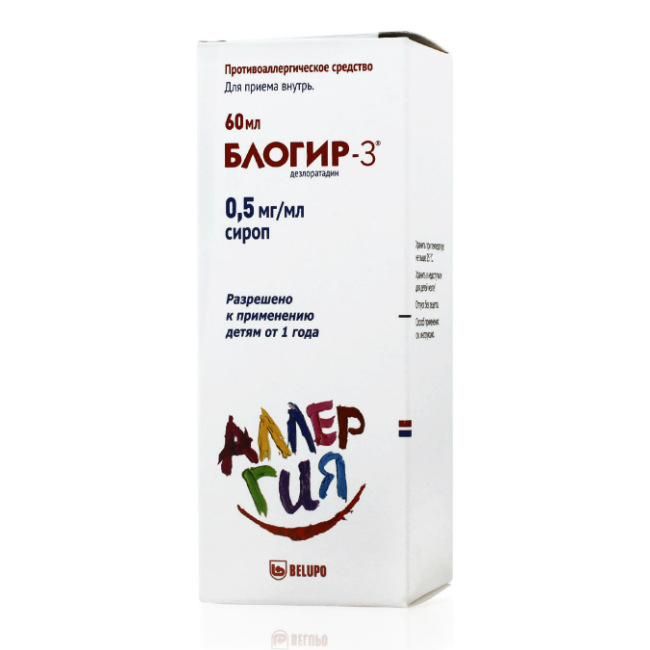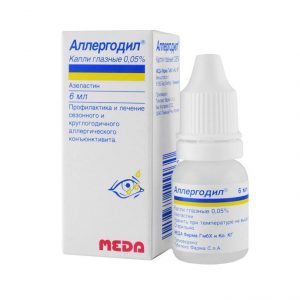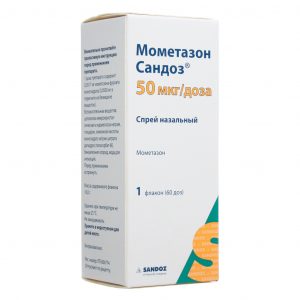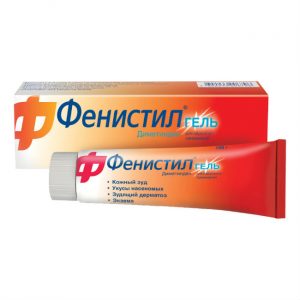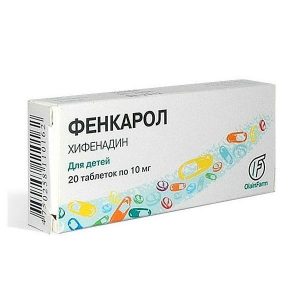Description
Pharmacological action
Non-sedating long-acting antihistamine. It is the primary active metabolite of loratadine. Selectively blocks the activity of peripheral H1 histamine receptors. Suppresses the release of histamine from mast cells. Inhibits a cascade of allergic inflammation reactions, including the release of anti-inflammatory cytokines, including interleukins IL-4, IL-6, IL-8, IL-13, the release of adhesion molecules such as P-selectin. Thus, it prevents the development and facilitates the course of allergic reactions, has an antipruritic and antiexudative effect, reduces capillary permeability, prevents the development of tissue edema, smooth muscle spasm.
The drug does not affect the central nervous system, practically does not have a sedative effect (does not cause drowsiness) and does not affect the speed of psychomotor reactions. Does not cause prolongation of the QT interval on the ECG.
Pharmacokinetics
Absorption
After oral administration, desloratadine is well absorbed in the gastrointestinal tract, determined in blood plasma 30 minutes after oral administration. The maximum concentration of Cmax is reached after about 3 hours.
Distribution of
The binding of desloratadine to plasma proteins is 83-87%. When used in adults and adolescents for 14 days at a dose of 5 mg to 20 mg once a day, no clinically significant cumulation of desloratadine was detected. The simultaneous ingestion of food or grapefruit juice does not affect the distribution of desloratadine (when taken in a dose of 7.5 mg once a day). Does not cross the blood-brain barrier.
Metabolism
Undergoes extensive metabolism in the liver by hydroxylation to form 3-OH-desloratadine coupled to glucuronide. It is not an inhibitor of CYP3A4 and CYP2D6 isoenzymes and is not a substrate or an inhibitor of P-glycoprotein.
Excretion
Desloratadine is excreted in the form of a glucuronide compound and in a small amount (less than 2%) by the kidneys and through the intestines (less than 7%) unchanged. The half-life of T1 / 2 is on average 27 hours
Indications
– Allergic rhinitis (elimination or relief of sneezing, nasal congestion, mucus discharge from the nose, itchy nose, itching of the palate, itching and redness of the eyes, lacrimation)
– urticaria (reduction or elimination of skin itching, rash).
Contraindications
Hypersensitivity to the drug components pregnancy and lactation age up to 1 year hereditary fructose tolerance disorders (due to the presence of sorbitol in the preparation).
With caution
In the presence of severe renal failure, the drug should be taken with caution.
Use during pregnancy and lactation
Use of the BLOGIR-3 ® syrup during pregnancy is contraindicated in the absence of clinical data on the safety of its use in this period.
Desloratadine is excreted in breast milk, so the use of the drug during breastfeeding is contraindicated.
Special instructions
Pediatric use
The efficacy and safety of using BLOGIR-3 ® syrup in children under 1 year of age has not been established.
In most cases, rhinitis in children under 2 years of age has an infectious nature. Studies of the effectiveness of desloratadine in rhinitis of an infectious etiology have not been conducted.
Differential diagnosis between allergic rhinitis and rhinitis of a different origin in children under the age of 2 years presents certain difficulties. When conducting a differential diagnosis, attention should be paid to the presence or absence of foci of infection or structural abnormalities of the upper respiratory tract, a thorough medical history, examination, as well as appropriate laboratory tests and skin tests.
Effect on the ability to drive vehicles and mechanisms
At the recommended dose, the drug does not affect the ability to drive vehicles or mechanisms. However, in very rare cases, some patients may experience drowsiness while taking desloratadine, which may affect their ability to drive vehicles or operate machinery.
Composition of
1 ml syrup contains:
active substance:
desloratadine 0.5 mg.
Excipients:
propylene glycol – 150.0 mg,
sorbitol – 150.0 mg,
hypromellose – 3.5 mg,
sucralose – 2.0 mg,
sodium citrate – 1.26 mg,
flavor of tutti-frutti (flavoring agents, propylene glycol E1520) – 0.75 mg,
citric acid – 0.5 mg,
water – qs
Side effects of
In clinical trials in children under 2 years of age with the use of the drug, the following adverse events were noted, the frequency of which was slightly higher than with placebo: diarrhea, fever, insomnia in children aged 2 to 11 years, the frequency of side effects was the same as when using placebo in adults and adolescents from 12 years of age when using the drug, the following adverse events were noted, the frequency of which was slightly higher than when using placebo: Weighted fatigue, dry mouth, headache.
Very rarely, the following side effects were noted:
From the central nervous system: hallucinations, dizziness, drowsiness, insomnia, psychomotor hyperactivity, convulsions.
From the cardiovascular system: tachycardia, palpitations.
From the digestive system: abdominal pain, nausea, vomiting, dyspepsia, diarrhea.
From the liver and biliary tract: increased activity of liver enzymes, bilirubin content, hepatitis.
From the musculoskeletal system: myalgia.
Allergic reactions: anaphylaxis, angioedema, dyspnea, itching, rash, including urticaria, photosensitivity.
If any of the side effects indicated in the instructions are aggravated, or you notice any other side effects not listed in the instructions, inform your doctor.
Drug Interactions
Interactions with repeated combined use of desloratadine with ketoconazole, erythromycin, azithromycin, fluoxetine and cimetidine have not revealed clinically significant changes in plasma concentration of desloratadine. BLOGIR-3 ® does not enhance the effect of alcohol on the central nervous system.
Eating does not affect the effectiveness of the drug.
Overdose of
In clinical trials with the use of desloratadine in a dose of up to 45 mg (9 times the therapeutic dose), no clinically significant adverse effects were observed.
Treatment: In case of overdose, standard measures are taken to remove the active substance from the gastrointestinal tract. Symptomatic and supportive therapy is recommended.
Desloratadine is not excreted during hemodialysis, the effectiveness of peritoneal dialysis has not been established.
Storage conditions
Store at a temperature not exceeding 25 ° C.
Keep out of the reach of children!
The Expiration of
is 3 years.
Active ingredient
desloratadine
Sredlkp pharmacy terms and conditions without a prescription p14f26f14f26f26p14f26p14f26p14f26 and 80 p14f26
Over-the-counter
Form of Treatment
simply entails dlya accepts vnutry
Appointment
For adults, For children 1 year or older
